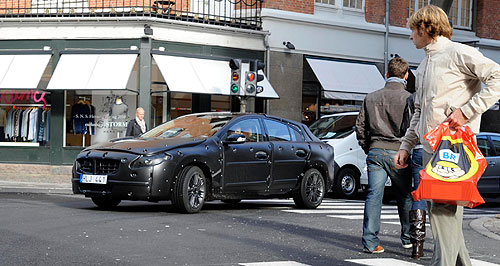Make / Model Search
Future models - Volvo - S60Safety-first Volvo S60 set for late 2010Testing times: Volvo engineers in Copenhagen test a disguised 2010 S60 fitted with crash avoidance technology that can detect pedestrians. Breakthrough pedestrian safety system confirmed for Australia in new Volvo S6016 Oct 2009 VOLVO’S next-generation S60 mid-size sedan will get world-first pedestrian anti-collision technology standard across the range when it arrives in Australia in the fourth quarter of 2010 – just months after its European release. The new detection system, which brakes the car automatically when a combination of radar and camera sensors calculate that any object – including a pedestrian – is moving on a collision course with the car, is in the final stages of testing in Europe in readiness for a global roll-out starting with the S60 in 2010. Volvo Car Overseas Corporation president Lex Kerssemakers told GoAuto during his first visit to Australia this week that the production version of the S60 – Volvo’s most important new-model launch of 2010 – will be unveiled at the Geneva motor show in March ahead of its European launch in July or August. He confirmed that Australia would be an early recipient of the new model, which first appeared in concept form at this year’s Detroit motor show in January. “The progress that Australia is making and the importance of the Australian market (to Volvo) after the successful XC60 launch, made us decide that (launch S60) before the end of the year,” he said.  From top: The Volvo S60 concept, Volvo Car Overseas president Lex Kerssemakers and Volvo's new detection system that can detect pedestrians and guage the distance. From top: The Volvo S60 concept, Volvo Car Overseas president Lex Kerssemakers and Volvo's new detection system that can detect pedestrians and guage the distance.Mr Kerssemakers, who is responsible for all Volvo markets outside of Europe, the US, Russia and China, said the S60 had the potential to rival the successful XC60 mid-sized SUV as Volvo Car Australia’s top seller. He said that while Australia was a good SUV market, it was equally strong for sedan sales. “It is a matter of having relevant cars,” he said. “It is hard to predict, but we are confident (of it being Volvo’s top-seller).” Mr Kerssemakers confirmed that the S60 would debut Volvo’s advanced 1.6-litre Gasoline Turbocharged Direct Injection (GTDi) engine that was shown in the original concept car, along with the latest bi-turbo version of Volvo’s five-cylinder turbo diesel. However, he cautioned that the GTDi four-cylinder engine might not be introduced immediately at S60 launch in Australia. “We are doing our utmost to have it together with the launch so we can offer a full range of engines,” he said. Mr Kerssemakers, who updated Australian Volvo dealers on the new-model plans at a meeting Sydney today (Friday), confirmed that the GTDi engine would be rolled out into other models after its S60 debut. In prototype form, the engine develops 134kW of power while averaging 5.0L/100km in fuel consumption and emitting 119 grams of CO2 per kilometre. Fuel economy is aided by idle-stop in city driving. The upgraded diesel, which uses the same cylinder block as the engine currently available in Australia, might make its debut as a running change to the XC60 next year. Said Mr Kerssemakers: “We will try to have it in the XC60, otherwise it will be a little bit late. In 2011, we should expect further rollouts of that engine.” The big news for the S60 is likely to be its new collision avoidance technology, which is a development of Volvo’s City Safety system currently available on the XC60 in Australia. The system – called Collision Warning and Full Auto Brake and Pedestrian Detection – was recently tested on disguised S60 prototypes in Copenhagen. Ten years in development, the system monitors the road ahead of the car, detecting objects by dual-mode radar, measuring the distance to them and then determining the type of object by video camera recognition. The driver is first alerted by an audible warning together with a flashing light in the windscreen head up display, resembling a brake light coming on. If the driver does not respond, the system automatically applies the brakes with full power. Previous systems have been primarily designed to protect against collisions with large objects, namely other cars. Some pre-pump the brakes for more effective braking, and in the case of the XC60’s City Safety, the system brakes the car automatically, but only operates at speeds up to 30km/h using a laser scanning eight metres ahead of the vehicle. By contrast, the new system works further ahead at higher speeds and even to the sides to detect, for example, pedestrians stepping off the kerb. Volvo hopes to avoid all collisions with pedestrians below 25km/h and to reduce the impact as much as possible – up to 75 per cent – in others. Volvo Cars Australia will be looking forward to the new model to revive the S60’s fortunes in this market. So far this year, S60 sales are down almost 30 per cent. The importer is also hoping its passenger car range will be lifted by facelifts to its large S80 – which has just arrived quietly on the market after being launched in Europe this year - and the C30 hatchback and C70 convertible which have just been shown at the Frankfurt motor show. The ‘C’ cars will arrive about March, with the C30 being headlined by the arrive of the eco-friendly C30 1.6D DRIVe diesel hatchback, which GoAuto understands will achieve one of Australia’s lowest official combined fuel economy ratings – 3.8L/100km. This will just pip the 3.9L/100km of the diesel Mini D, which uses the same engine co-developed by a consortium of Volvo, BMW and France’s PSA, but will trail Ford's Econetic Fiesta by 0.1L/100k. A facelifted S80 flagship has also just quietly arrived on the Australian market, although Volvo is still trying to run out the previous model before promoting its new wares.  Read more2nd of September 2009  First look: Volvo smoothes over C70Facelifted Volvo C70 emerges ahead of Frankfurt as prices slashed on outgoing modelAll future models Alfa Romeo Alfa Romeo Abarth Abarth Alpine Alpine Alpina Alpina Audi Audi Aston Martin Aston Martin BMW BMW Bentley Bentley Chery Chery Brabham Brabham Chrysler Chrysler Chevrolet Chevrolet Cupra Cupra Citroen Citroen DS DS Dodge Dodge Fiat Fiat Ferrari Ferrari Foton Foton Ford Ford Great Wall Great Wall FPV FPV Haval Haval GWM GWM Honda Honda Holden Holden Hummer Hummer HSV HSV Infiniti Infiniti Hyundai Hyundai Jaguar Jaguar Isuzu Isuzu Kia Kia Jeep Jeep Land Rover Land Rover Lamborghini Lamborghini Lexus Lexus LDV LDV Mahindra Mahindra Lotus Lotus Mazda Mazda Maserati Maserati Mercedes-AMG Mercedes-AMG McLaren McLaren MG MG Mercedes-Benz Mercedes-Benz Mitsubishi Mitsubishi Mini Mini Opel Opel Nissan Nissan Peugeot Peugeot Pagani Pagani Proton Proton Porsche Porsche Renault Renault Ram Ram Rover Rover Rolls-Royce Rolls-Royce Skoda Skoda Saab Saab SsangYong SsangYong Smart Smart Suzuki Suzuki Subaru Subaru Toyota Toyota Tesla Tesla Volvo VolvoS60 pricing
Motor industry news |
Click to shareVolvo modelsResearch Volvo All future models Alfa Romeo Alfa Romeo Abarth Abarth Alpine Alpine Alpina Alpina Audi Audi Aston Martin Aston Martin BMW BMW Bentley Bentley Chery Chery Brabham Brabham Chrysler Chrysler Chevrolet Chevrolet Cupra Cupra Citroen Citroen DS DS Dodge Dodge Fiat Fiat Ferrari Ferrari Foton Foton Ford Ford Great Wall Great Wall FPV FPV Haval Haval GWM GWM Honda Honda Holden Holden Hummer Hummer HSV HSV Infiniti Infiniti Hyundai Hyundai Jaguar Jaguar Isuzu Isuzu Kia Kia Jeep Jeep Land Rover Land Rover Lamborghini Lamborghini Lexus Lexus LDV LDV Mahindra Mahindra Lotus Lotus Mazda Mazda Maserati Maserati Mercedes-AMG Mercedes-AMG McLaren McLaren MG MG Mercedes-Benz Mercedes-Benz Mitsubishi Mitsubishi Mini Mini Opel Opel Nissan Nissan Peugeot Peugeot Pagani Pagani Proton Proton Porsche Porsche Renault Renault Ram Ram Rover Rover Rolls-Royce Rolls-Royce Skoda Skoda Saab Saab SsangYong SsangYong Smart Smart Suzuki Suzuki Subaru Subaru Toyota Toyota Tesla Tesla Volvo VolvoS60 pricing
Motor industry news |











Facebook Twitter Instagram